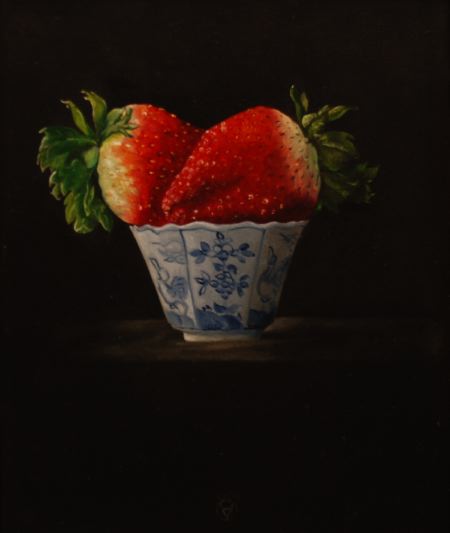
Artist and writer Jannie Regnerus has collected three paintings by my partner, Hanneke van Oosterhout. I went to Jannie’s house today to make a photograph of one of the paintings and to see if there was any chance that she would consider reselling them.

KARL ZIPSER: What do you think about these paintings you bought?
JANNIE REGNERUS: I like the intimacy of the painted objects. They have been cut off from their former lives as useful or functional things — especially the ginger pot. The ginger pot whispers its own history and has its own universe. The pears have a different feeling, they are sensual, almost like human bodies. And the strawberries have some humor because the proportions are confusing, the giant berries in the tiny cup.
KARL ZIPSER: Don’t you find these pictures a bit too dark?

JANNIE REGNERUS: I like the way the objects sink within this black background. They are very silent, but also very strong. I like these better than the paintings with the light background. Hanneke is very good in this dark and intimate night atmosphere. l like the tempered light, the sun has set, this is the best time for objects, they become more mysterious than they are in the broad daylight.
KARL ZIPSER: Would you sell these paintings? Perhaps you could buy something different, like a new stereo system?
JANNIE REGNERUS: Of course not. I bought them because I love them. I saw them and I wanted to have them close by. I didn’t buy them as an investment. When people come to my house they also want them. Hanneke made one picture for friends of mine who saw her work here. Every time I visit Hanneke’s studio I see new things, so it is very difficult for me to go there.
KARL ZIPSER: But you don’t like everything she makes.
JANNIE REGNERUS: Sometimes she works too long on a painting and I think that I liked it better at an earlier state. That is normal, it happens to me, I think it happens to every artist sometimes.
KARL ZIPSER: I agree, working too far is often a danger.
JANNIE REGNERUS: So Karl, what will be the prices of Hanneke’s paintings in the exhibition that begins this Friday?
KARL ZIPSER: That is an interesting question.
. . .
Hanneke’s show opens 15 December in Haarlem at gallery De Provenier (which does not have its own website). What will be the prices? Which pictures will she select for the exhibition? Will she, should she, sell on-line as well? All of these questions are unresolved. Hanneke will discuss the progress of the show on her own site.





 Recently we looked at one of
Recently we looked at one of